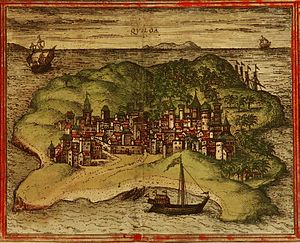| Sack of Kilwa | |||||||
|---|---|---|---|---|---|---|---|
| Part of the Portuguese battles in the East | |||||||
 Kilwa Kisiwani, on the Tanzanian coast. From Civitates orbis terrarum vol. I, by Georg Braun and Franz Hogenberg, 1572 | |||||||
| |||||||
| Belligerents | |||||||
|
|
| ||||||
| Commanders and leaders | |||||||
|
|
| ||||||
| Strength | |||||||
| Around 500 men | Unknown | ||||||
The Sack of Kilwa (Portuguese: Saque de Quiloa) was a military campaign carried out by the Portuguese on 24 July 1505, led by Dom Francisco de Almeida, against the city-state of the Kilwa Sultanate. The operation resulted in a decisive Portuguese victory and the sacking of Kilwa, a prominent trading hub along the Swahili Coast.
After sacking Kilwa, the Portuguese built Fort Santiago in the city before proceeding to attack Mombasa. However, they lost Kilwa to Arab mercenaries in 1512. The Portuguese ultimately regained permanent control of Kilwa in 1597.[1]
- ^ Tony Jaques, Dictionary of Battles and Sieges: A Guide to 8,500 Battles from Antiquity Through the Twenty-first Century, volume 3, p. 532, Bloomsbury Publishing, 2006, ISBN 9780313027994.
